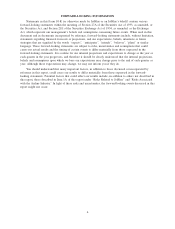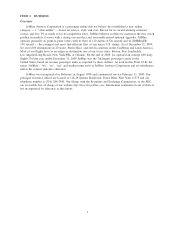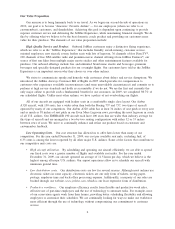JetBlue Airlines 2009 Annual Report Download - page 17
Download and view the complete annual report
Please find page 17 of the 2009 JetBlue Airlines annual report below. You can navigate through the pages in the report by either clicking on the pages listed below, or by using the keyword search tool below to find specific information within the annual report.
Aircraft Fuel
In 2009, continuing a trend that began in 2005, fuel costs were our largest operating expense. Fuel prices
and availability are subject to wide price fluctuations based on geopolitical factors and supply and demand
that we can neither control nor accurately predict. We use a third party fuel management service to procure
most of our fuel. Our historical fuel consumption and costs were as follows for the years ended December 31:
2009 2008 2007
Gallons consumed (millions) ..................... 455 453 444
Total cost (millions) ........................... $945 $1,397 $ 968
Average price per gallon ........................ $2.08 $ 3.08 $2.18
Percent of operating expenses .................... 31.4% 42.6% 36.2%
Total cost and average price per gallon each include related fuel taxes as well as effective fuel hedging
gains and losses.
In the second quarter of 2009, we resumed fuel hedging after suspending our hedge activity at the end of
2008. Our goal is to mitigate our liquidity exposures and provide some protection against significant increases
in fuel prices by entering into a variety of crude call options, heating oil collar contracts, and jet fuel swap
agreements. At December 31, 2009, we had hedged approximately 40% of our projected 2010 fuel
requirements and 3% of our projected 2011 fuel requirements. We had no collateral posted related to margin
calls on our outstanding fuel hedge contracts as of December 31, 2009.
LiveTV, LLC
LiveTV, LLC, a wholly owned subsidiary of JetBlue, provides in-flight entertainment, voice
communication and data connectivity services for commercial and general aviation aircraft. LiveTV’s assets
include certain tangible equipment and interests in systems installed on its customers’ aircraft, system
components and spare parts in inventory, an air-to-ground spectrum license granted by the Federal
Communications Commission, a network of approximately 100 ground stations across the continental U.S.,
and rights to certain patents and intellectual property. LiveTV’s major competitors in the in-flight
entertainment systems market include Rockwell Collins, Thales Avionics and Panasonic Avionics. Only
Panasonic is currently providing in-seat live television. In the voice and data communication services market,
LiveTV’s primary competitors are Aircell, Row 44, Panasonic, OnAir and Aeromobile.
LiveTV has agreements with eleven other domestic and international commercial airlines for the sale and
installation of certain hardware, programming and maintenance of its live in-seat satellite television as well as
XM Satellite Radio service and certain other products and services. LiveTV also has general aviation
customers to which it supplies voice and data communication services. LiveTV continues to pursue additional
customers and related product enhancements.
Government Regulation
General. We are subject to regulation by the DOT, the FAA, the Transportation Security Administration,
or TSA, and other governmental agencies. The DOT primarily regulates economic issues affecting air service
such as certification and fitness, insurance, consumer protection and competitive practices. The DOT has the
authority to investigate and institute proceedings to enforce its economic regulations and may assess civil
penalties, revoke operating authority and seek criminal sanctions. In February 2000, the DOT granted us a
certificate of public convenience and necessity authorizing us to engage in air transportation within the
United States, its territories and possessions.
The FAA primarily regulates flight operations and, in particular, matters affecting air safety such as
airworthiness requirements for aircraft, the licensing of pilots, mechanics and dispatchers, and the certification
of flight attendants. The civil aviation security functions of the FAA were transferred to the TSA under the
Aviation and Transportation Security Act. The FAA requires each airline to obtain an operating certificate
authorizing the airline to operate at specific airports using specified equipment. We have and maintain FAA
8
























